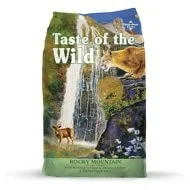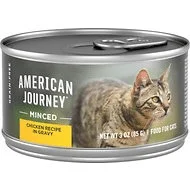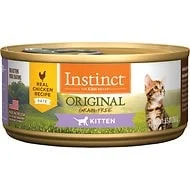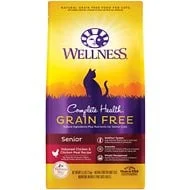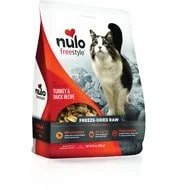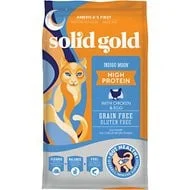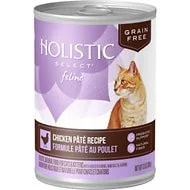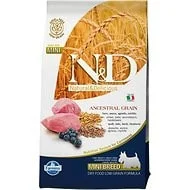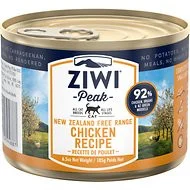10 Best Cat Food Without Dyes in 2025
Quick Guide
- What Is The Best Cat Food Without Dyes?
- What You Need to Know About Dyes in Cat Food
- What Are the Biggest Food Dyes to Avoid?
- What Should You Look for in a Healthy Cat Food?
- How Do We Make Cat Food Recommendations?
- The 10 Best Cat Foods Without Dyes
- Smalls Fresh Food Delivery
- Taste of the Wild Rocky Mountain Grain-Free Dry Food
- American Journey Minced Chicken Recipe in Gravy Grain-Free Canned Food
- Instinct by Nature’s Variety Kitten Grain-Free Real Chicken Recipe Canned Food
- Wellness Complete Health Chicken & Deboned Chicken Grain-Free Senior Dry Food
- Nulo Freestyle Raw Turkey & Duck Freeze-Dried Cat Food
- 4 More Top-Rated Cat Foods without Dyes
- Frequently Asked Questions
If you opened a bag of cat food to find it full of dull, gray-colored kibbles you probably wouldn’t feel too good about feeding it to your cat. Even if you’re not an expert in biology, you understand on some level that your cat is a carnivore and he deserves to eat meat. Most cat foods (particularly premium-quality cat foods) contain decent levels of meat, but they are so heavily processed that they don’t end up looking like it. Food dyes and other additives help cat foods look more appealing to pet parents.
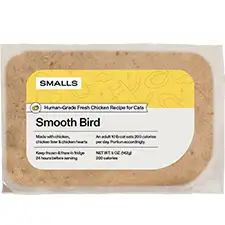
Smalls Human-Grade Ground Bird Fresh Cat Food
- Natural sources of taurine
- High in protein
Read that sentence again – more appealing to pet parents. Cats don’t particularly care what color their food is, so food dyes serve absolutely no benefit for your cat. That doesn’t mean they’re harmless, however. In fact, it’s very much the opposite. Some of the most common food dyes in cat food have been linked to serious health issues.
In this article, we’ll talk about food dyes in cat food including what they are and what problems they can cause in cats. You’ll also learn what you need to look for in a healthy cat food and see our top picks for the best dye free cat food.
What Is The Best Cat Food Without Dyes?
- Smalls Fresh Food Delivery
- Taste of the Wild Rocky Mountain
- American Journey Minced Chicken
- Instinct by Nature’s Variety Kitten
- Wellness Complete Health Chicken
- Nulo Freestyle Raw Turkey & Duck
- Solid Gold Indigo Moon with Chicken & Eggs
- Holistic Select Chicken Pate Recipe
- Farmina Natural & Delicious Lamb
- Ziwi Peak Chicken Recipe Canned
What You Need to Know About Dyes in Cat Food
There’s a great deal of misinformation out there about additives in cat food, especially dyes. You’ve probably heard of people being allergic to certain dyes (particularly yellow #5), but what about pets?
Many pet food manufacturers that use dyes in their products make the argument that they are “generally recognized as safe” by the FDA. For example, Dr. Sarah Skinner suggests in this article that food coloring and dyes in cat food are not harmful. This argument is based on FDA definitions and a handful of studies, but this information is limited and outdated. The primary argument in this document is that food dyes don’t cause allergies in cats and dogs. That may or may not be true, but it doesn’t tell the whole story – there are other ways a substance can do harm.
In 1906, the FDA banned the use of toxic food colors containing mercury, arsenic, and lead. This still left plenty of options, however, including dyes made from the byproducts of coal processing known as coal-tar dyes. Over time, these colors were also found to be problematic and the Color Additives Amendments of 1960 were created to enforce more stringent oversight in the safety of color additives in both human and animal foods.
Today, the FDA regulates the use of color additives in human and animal foods and they are generally divided into two categories: those that need FDA certification and those that don’t. Certified colors are man-made and the list numbers less than 10. Colors exempt from certification include natural pigments from plants, animals, or minerals.
That sounds perfectly fine, doesn’t it? But there’s more to the story.
Many pigments can be derived from natural sources, but not all of them are safe. Turmeric is often used in creating yellow dye and has little risk to your cat. Titanium dioxide, on the other hand, is not so safe. Technically speaking, it is a naturally occurring oxide of titanium, so it isn’t classified as an artificial color. It is used as a white pigment in pet food has been shown to carcinogenic potential. Iron oxide is simply a compound of iron and oxygen often used as a red pigment in pet food.
Titanium oxide and iron oxide are examples of modified minerals which don’t fall under the umbrella of artificial coloring agents but still have the potential to do harm.
What Are the Biggest Food Dyes to Avoid?
The simplest way to find cat food without dyes is to stick with the higher quality brands on the market. Many will have a statement on the package that the product is free from artificial colors or dyes. If you don’t see this on the package (or even if you do), check the ingredients list and look for anything with a number (like red dye 40). Dyes with numbers aren’t the only ones to avoid, but they are the most common and the most studied in regard to their health risks.
Something else you may see on a pet food label is the term “natural color.” This could come from natural plant pigments, or it might night. Think back to the example of titanium dioxide and iron oxide, both derived from minerals which are inherently natural, but they still aren’t completely safe.
Here are the primary food dyes to avoid in cat food:
- Yellow 5 – Also known as tartrazine, this dye is responsible for many human allergies and is required to carry a warning label in Europe. It is thought to cause neurochemical and behavioral issues like aggression and hyperactivity. It is also linked to thyroid tumors and lymphomas.
- Red 40 – The most common and well-known dye in food products, red dye 40 is tainted with cancer-causing contaminants and has also been linked to ADHD and hyperactivity.
- Blue 2 – This dye may cause allergic reactions and often contains cancer-causing contaminants linked to abnormal cell development, especially in the brain.
- Yellow 6 – This dye has been linked to allergies and hyperactivity. It may also be linked to adrenal gland and kidney tumors in animals as well as skin problems and chromosomal damage.
- Titanium Dioxide – A white pigment used in pet foods, titanium dioxide has been identified as potentially carcinogenic. It has also been linked to DNA damage, inflammation, and genetic disorders in pets.
- Iron Oxide – Often used in cheap cat food to give it red color (more like meat) and has been identified as an irritant to the skin and eyes.
In addition to these food dyes in cat food, you may also want to keep an eye out for red dye 3. The use of this dye has become much less common since the FDA banned many of its uses in the 1990s, but it doesn’t hurt to be vigilant! Now read on to find out what you DO want to see in your cat’s food.
What Should You Look for in a Healthy Cat Food?
Your cat is an obligate carnivore which means his body is biologically evolved to derive nutrition most efficiently from animal sources. If it’s not meat, your cat’s body can’t process it as well. That primarily applies to carbohydrates in cat food, but additives like food dyes are no different. They serve no nutritional value and come with health risks – why wouldn’t you want to avoid them?
You should always avoid artificial coloring in cat food, but what DO you want in your cat’s food? Here’s what to look for in cat food:
- Real animal protein as the first ingredient. As an obligate carnivore, your cat has high needs for protein in his diet, specifically from animal sources like meat, poultry, and fish.
- Balanced omega-3 and omega-6 fatty acids. Health fats provide your cat with a concentrated source of calories as well as essential fatty acids. Omega 3s and 6s support your cat’s skin and coat health as well and should be in proper balance.
- Limited content of digestible carbohydrates. Your cat has very little ability to efficiently digest plant foods, so avoid carb-heavy recipes. Any carbs in your cat’s diet should come from nutritious and digestible sources like whole grains or low-starch veggies.
- Natural sources for key nutrients. Speaking of veggies, they are the best natural source of vitamins and minerals (so are fruits). Look for a recipe that uses natural sources for key nutrients and it’s overstuffed with synthetic supplements.
- No artificial additives. Not only should you avoid artificial colors and dyes, but you also want to choose a cat food free from artificial flavors and preservatives.
Now that you know what to look for in a high-quality cat food recipe, you’re ready to start shopping on your own! Before you do, however, we want to tell you how we make our cat food recommendations so you know whether you can trust the picks we’ve reviewed in depth below.
How Do We Make Cat Food Recommendations?
We know you love your cat and we want what’s best for him just as much as you do. The difference is that we’ve done a ton of research to learn exactly what goes into pet food and how to decipher the information on pet food labels. Don’t worry – we’re using our powers for good! Your cat’s good, that is. We’ve evaluated many of the top cat food brands on the market, so we know what we’re talking about, and we’d never recommend something we wouldn’t feed our own cats.
Here are some general requirements for a cat food recipe to receive our stamp of approval:
- A source of high-quality animal protein as the first ingredient
- At least 30% crude protein for kittens and at least 26% for adults
- A minimum of 9% crude fat for kittens and adults
- A balance of omega-3 and omega-6 fatty acids, primarily from animal sources
- A rich blend of nutrients from natural sources and supplements, as needed
- Limited carbohydrate content from digestible sources (like whole grains and veggies)
- No low-quality fillers, by-products, or artificial additives (preservatives, dyes, or flavors)
The 10 Best Cat Foods Without Dyes
The best food is one that will provide for your cat’s nutritional needs in a healthy way. That means real ingredients, especially real animal protein. Be sure to pick a recipe appropriate for your cat’s life stage and check the ingredients list for red flags. To help you get started, here are our top picks for the best food without dyes:
| Our 2025 Picks: Best Cat Foods Without Dyes | |||
Small Ground Bird Human-Grade Fresh Cat Food
|
CHECK PRICE | ||
Taste of the Wild Rocky Mountain
|
CHECK PRICE | ||
American Journey Minced Chicken Recipe
|
CHECK PRICE | ||
Instinct by Nature’s Variety Kitten
|
CHECK PRICE | ||
Wellness Complete Health Chicken
|
CHECK PRICE | ||
Nulo Freestyle Raw Turkey & Duck
|
CHECK PRICE | ||
Solid Gold Indigo Moon with Chicken & Eggs
|
CHECK PRICE | ||
Holistic Select Chicken Pate
|
CHECK PRICE | ||
Farmina Natural & Delicious Lamb
|
CHECK PRICE | ||
Ziwi Peak Chicken Recipe Canned Food
|
CHECK PRICE | ||
Smalls Fresh Food Delivery
Our Top Overall Pick: If you want to feed your cat the best of the best, fresh food is definitely an option you should consider. Commercial dry food is cooked at extremely high temperatures which denatures the proteins and reduces the nutritional value – that’s why cat food companies have to add so many synthetic nutrients. These foods also tend to be modified with dyes and flavors to make them more appealing. Fresh food is more flavorful and appealing naturally because it is made from better ingredients and not cooked to death. Smalls is our favorite fresh food company. They offer two protein options (chicken or fish) and both recipes are made with wholesome, natural ingredients. Their formulas are gently cooked in small batches to guarantee freshness and quality and they are customized according to your cat’s calorie requirements. Plus, no food dyes or any artificial additives of any kind!
Taste of the Wild Rocky Mountain Grain-Free Dry Food
Most Popular Cat Food without Dyes: It can be tough to choose a cat food brand with so many options out there but Taste of the Wild is a popular choice and one we think worthy of consideration. This Rocky Mountain grain-free dry food is a great option because it features premium roasted meats to deliver unbeatable natural flavor. It is packed with protein from animal sources like chicken meal, roasted venison, and smoked salmon with fresh fruits and vegetables to provide natural sources for key nutrients. Dried fermentation products act as probiotics to support your cat’s healthy and regular digestion as well. No food dyes!
American Journey Minced Chicken Recipe in Gravy Grain-Free Canned Food
Most Affordable Cat Food without Dyes: You should feed your cat the highest quality food you can consistently afford, but you don’t necessarily need to spend a fortune. This minced chicken recipe canned food from American Journey is very affordable and loaded with high-quality ingredients. It starts with fresh chicken as the main ingredient and includes both chicken and turkey broth as flavorful sources of moisture. Sunflower oil and fish oil provide a rich blend of omega-3 and omega-6 fatty acids while cranberries and blueberries provide antioxidants and essential nutrients. You’ll find this recipe supplemented with vitamins and chelated minerals, but no food dyes and not an artificial additive in sight.
Instinct by Nature’s Variety Kitten Grain-Free Real Chicken Recipe Canned Food
Best Kitten Food without Dyes: Kittens often find canned food more palatable than dry food and this kitten recipe is just what your kitten needs to get off to a healthy start. It features fresh chicken as the main ingredient with salmon and beef liver as supplemental sources of protein. This recipe contains plenty of healthy fats to supply your kitten with the energy he needs to grow with natural sources of DHA for healthy brain and eye development. This recipe contains only healthy, natural ingredients including fresh fruits and vegetables for nutritional support. There are no artificial additives of any kind.
Wellness Complete Health Chicken & Deboned Chicken Grain-Free Senior Dry Food
Best Senior Cat Food without Dyes: Senior cats still have high needs for protein to maintain lean mass and healthy body weight, but they may not need as many calories as they did in their youth. This Wellness Complete Health senior recipe is a great choice because it is packed with lean protein with controlled fat and calories. This recipe includes the Wellness WellFlex System which contains added glucosamine and chondroitin for joint support – it also contains plenty of fiber and L-carnitine to help manage the metabolism. Overall, it delivers complete and balanced nutrition with a minimum of 39% protein and 11% fat at 444 calories per cup.
Nulo Freestyle Raw Turkey & Duck Freeze-Dried Cat Food
Best Cat Food without Dyes for Sensitive Stomach: Cats with sensitive stomachs often have difficulty digesting carbohydrate ingredients. Looking for a high-protein recipe with a limited number of ingredients can help reduce the risk of triggering a sensitivity. This Nulo Freestyle Raw Turkey & Duck Freeze-Dried Cat Food is a great option. It contains 98% animal-based ingredients including turkey, turkey necks, turkey liver, duck liver, and more. The only carbohydrates are flaxseed and cranberries which also provide beneficial nutrients like omega fatty acids and antioxidants. Plus, this recipe is freeze-dried which preserves the nutritional integrity of the raw ingredients more than high-heat cooking processes.
4 More Top-Rated Cat Foods without Dyes
Solid Gold Indigo Moon with Chicken & Eggs Grain-Free High-Protein Dry Food
Packed with protein and healthy nutrients, this Solid Gold Indigo Moon with Chicken & Eggs is free from all artificial additives including food dyes. It features chicken and egg as the primary proteins and is formulated to support gut health in cats of all life stages. This recipe contains 42% crude protein which is much more than the recommended minimum and it comes from digestible animal sources. A unique blend of superfoods provides natural sources for key nutrients in addition to supporting your cat’s gut and immune health.
Holistic Select Chicken Pate Recipe Grain-Free Canned Food
Some cats simply prefer canned food and we like this Holistic Select Chicken Pate Recipe Grain-Free Canned Food. It features fresh chicken and chicken liver as the top two ingredients with turkey as a supplemental source of protein. Apple, cranberry, and pumpkin powders deliver natural sources for key nutrients in addition to dietary fiber for digestive support. This recipe also contains prebiotics and probiotics for healthy digestion and optimal nutrient absorption.
Farmina Natural & Delicious Lamb & Ancestral Low-Grain Formula Dry Food
Protein is the most important nutrient in your cat’s diet, but whole grains aren’t necessarily bad. This Farmina Natural & Delicious Lamb & Ancestral Low-Grain Formula still delivers 60% animal ingredients and 94% animal protein – 20% of the remainder comes from organic spelt and oats with 20% from fruits, vegetables, and supplemental nutrients. This is a low-glycemic formula so it won’t spike your cat’s blood sugar and it is completely free from artificial additives including food dyes.
Ziwi Peak Chicken Recipe Canned Food
If you’re looking for a simple recipe that delivers balanced nutrition, try this Ziwi Peak Chicken Recipe Canned Food. It contains a single carbohydrate ingredient (chickpeas) and lots of protein. Not only does it contain fresh chicken, but it also contains chicken necks and nutritious chicken organs. New Zealand mussels provide a natural source of joint-supporting glucosamine and chondroitin. The only other ingredients are supplemental vitamins and minerals – no food dyes!
Frequently Asked Questions
- Is food coloring safe for cats? There isn’t a simple answer to this question because there are so many angles to it. While the FDA lists certain dyes and colors (even some of the artificial ones) as safe, there is mounting evidence that they may not be. You also have to remember that dogs and cats are different than humans, not to mention the fact that many scientific studies are done using mice. It’s difficult to tell exactly how something will affect a dog or cat until a long-term study has been completed.
- Are natural colors safe for cats? Generally speaking, natural colors are probably better than artificial colors, but they aren’t all safe. Pigments derived from food like turmeric for yellow coloring are better than modified minerals like titanium oxide and iron oxide. The more important thing to think about, however, is why there are colors in the food at all. They serve no nutritional value and no benefit for your cat, they just make the product a little more appealing to people.
- Can cats be allergic to dyes and colors? Cats experience allergies in different ways than people do. Yellow dyes 5 and 6 are known to cause allergies in humans, but they may cause a slightly different reaction in pets – still negative, but it may not be immune-mediated like a human allergy. Allergies in cat food are more commonly caused by proteins. This isn’t to say your cat won’t react to artificial dyes, but it may not be an allergic reaction.
If you want your cat to live a long and healthy life, it’s your job to find the best quality cat food you can. There is no single “best” cat food out there because every cat has his own dietary requirements and preferences. Generally speaking, however, dye free cat food is better than the alternative. If you’re not sure where to start in looking for cat food without red dye or other colors, simply try one of the recipes we’ve recommended above!


